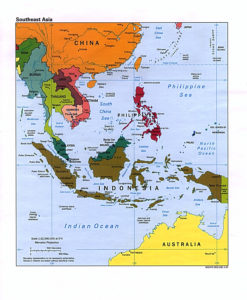 There are two types of power evident in the study of international relations: hard power and soft power. The former is coercive, and is associated with a state’s use of military force or economic pressure in order to maximize its interests. Hard power is advocated by those who believe that relative gains are the most important facet of inter-state relations. The latter is cooperative, and is associated with diplomatic engagement and co-optation. Soft power is promoted by liberals who contend that the value of absolute gains will result in better inter-state relations. The conditions under which hard and soft power are employed by hegemons within their regional domains can be an interesting insight into how foreign policy is crafted at the state level, and how successful regional powers will be maintaining their influence over time.
There are two types of power evident in the study of international relations: hard power and soft power. The former is coercive, and is associated with a state’s use of military force or economic pressure in order to maximize its interests. Hard power is advocated by those who believe that relative gains are the most important facet of inter-state relations. The latter is cooperative, and is associated with diplomatic engagement and co-optation. Soft power is promoted by liberals who contend that the value of absolute gains will result in better inter-state relations. The conditions under which hard and soft power are employed by hegemons within their regional domains can be an interesting insight into how foreign policy is crafted at the state level, and how successful regional powers will be maintaining their influence over time.
There has been a lot of talk of China’s potential hegemony. It is clearly a state whose influence in the international arena is increasing: its economy continues to grow at an impressive rate which has consequently allowed it to improve and expand its military capacity. As a rising international power in the 21st century, it is interesting to discern whether China’s ascension to global supremacy will result in a more respectful nature of its neighbors and a commitment to cooperation or if it will resort to taking a hard line approach.
China’s military arsenal gives it a relative advantage over many of its Southeast Asian neighbors. Beijing has rapidly acquired and produced naval warships, has expanded development of its intelligence gathering techniques, and has held joint military exercises with fellow nuclear powers Pakistan and India. It is also trying to project a “more robust” military presence in the South China Sea — site of an ongoing territorial dispute — enabling China’s navy to conduct better surveillance, enforce strategic blockades, and control the high level of sea traffic which passes through the area, according to a U.S. Department of Defense report produced earlier this year.
However, rather than resort to military measures to aggressively halt the conflict in the Spratly Islands, China has shown remarkable restraint. In July 2011, China and Association of Southeast Asian Nations (ASEAN) member states began plans to implement the Declaration on the Conduct of Parties in the South China Sea, an agreement signed by the members back in 2002 but lacking any real bite. Article five of the declaration suggests several ways “in the spirit of cooperation and understanding, to build trust and confidence between and among” the parties.
a. holding dialogues and exchange of views as appropriate between their defense and military officials;
b. ensuring just and humane treatment of all persons who are either in danger or in distress;
c. notifying, on a voluntary basis, other Parties concerned of any impending joint/combined military exercise; and
d. exchanging, on a voluntary basis, relevant information.
The declaration discourages unilateral action as well as attempts to resort to military means to resolve the dispute.It splits the sea into disputed and non-disputed areas, calling for the former to be demilitarized and subject to joint patrols and usage. Building upon that minor success, China and Vietnam signed a six-point agreement in October 2011 which sought to end the maritime dispute and make the region a zone “of peace, friendship and cooperation.”
On monetary matters, China and Southeast Asia’s economic relationship is mutual. China’s incredible pace of industrialization has given Beijing the ability to manufacture scores of cheap goods, resulting in exceptional export numbers. Furthermore, the market for Chinese goods is particularly helped in Southeast Asia by the creation of the ASEAN-China Free Trade Agreement (ACFTA), which has resulted in greater integration between Beijing and ASEAN member states which can export the essential raw materials needed for industrial manufacturing in China. ACFTA went into effect on January 1st, 2010 and is the largest free trade area in the world in terms of population. The agreement reduces 90 per cent of tariffs on imports and encourages the transnational exchange of goods and services with a minimum of regulation.
Moreover, Beijing’s decision to join the World trade Organization (WTO) in November 2001 has not harmed the ASEAN member states’ economic prosperity but in fact has strengthened it. Jose Tongzon has studied the effect China’s liberalization has had on the economic prospects of Southeast Asia and, despite initial apprehensions, his research shows that there have been net benefits and absolute gains realized by both China and ASEAN members.
In sum, it is my contention that China has excellent potential as a regional and, eventually, as a global hegemon because of its ability to pursue a multi-track approach to issues of vital interest, its profitable economic relationship with the nations of Southeast Asia, and its propensity to use soft power as a way of spreading its influence.